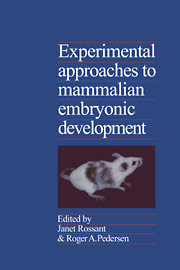Book contents
- Frontmatter
- Contents
- Preface
- Contributors
- Cellular aspects
- Molecular and biochemical aspects
- 6 Regulation of gene expression during mammalian spermatogenesis
- 7 Molecular aspects of mammalian oocyte growth and maturation
- 8 Utilization of genetic information in the preimplantation mouse embryo
- 9 Metabolic aspects of the physiology of the preimplantation embryo
- 10 Role of cell surface molecules in early mammalian development
- 11 Cell-lineage-specific gene expression in development
- 12 X-chromosome regulation in oogenesis and early mammalian development
- Toward a genetic understanding of development
- Index
12 - X-chromosome regulation in oogenesis and early mammalian development
from Molecular and biochemical aspects
Published online by Cambridge University Press: 31 March 2010
- Frontmatter
- Contents
- Preface
- Contributors
- Cellular aspects
- Molecular and biochemical aspects
- 6 Regulation of gene expression during mammalian spermatogenesis
- 7 Molecular aspects of mammalian oocyte growth and maturation
- 8 Utilization of genetic information in the preimplantation mouse embryo
- 9 Metabolic aspects of the physiology of the preimplantation embryo
- 10 Role of cell surface molecules in early mammalian development
- 11 Cell-lineage-specific gene expression in development
- 12 X-chromosome regulation in oogenesis and early mammalian development
- Toward a genetic understanding of development
- Index
Summary
Introduction
The X chromosome in placental mammals is subject to a unique system of developmental regulation. This regulation involves coordinate activation and inactivation of the entire chromosome during the course of female development. The inactivation event occurs during early embryogenesis, and, once established, the inactive condition is somatically heritable in a cell lineage. The inactivation event in the embryonic lineages typically occurs at random with respect to the parental origin of X chromosomes such that the developing embryo and resulting adult is a mosaic with respect to X-chromosome expression. The primordial germ cells of the developing fetus appear to be similar to somatic cells with respect to single active X expression, and the mature X is reactivated in oogonial stages prior to the onset of meiotic prophase.
The molecular mechanisms involved in the onset of inactivation and the maintenance of inactive X chromosomes are not well established, but there is an increasing amount of evidence that DNA modification, probably in the form of cytosine methylation, is involved. Moreover, there is ample evidence to suggest that DNA methylation is also associated with changes in chromatin structure and that the critical methylation changes in the inactive X chromosome occur in gene promoter regions and other regulatory sites (Wolf and Migeon 1985).
This review is primarily concerned with the elements of X-chromosome regulation that take place in the early embryo.
- Type
- Chapter
- Information
- Experimental Approaches to Mammalian Embryonic Development , pp. 365 - 398Publisher: Cambridge University PressPrint publication year: 1987
- 3
- Cited by



